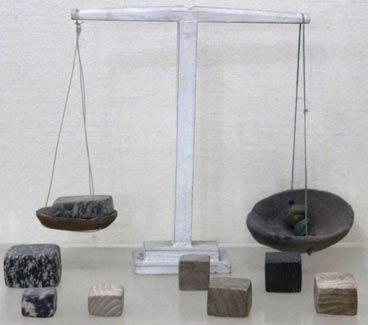The Priestking and Male Torso Reveal That Early Indus Valley Art Is
The Indus Valley Civilisation was rich with civilisation and tradition, revealed in its wealth of beautiful, intricate, and elaborate ornaments, jewelry and artifacts. These items and more are on exhibit at India's Jewellery Gallery of the National Museum in Delhi .
According to Deoxyribonucleic acid India , the display represents the loftier aesthetic sense of the craftsmen of Old Earth culture, and the connexion between culture then and at present through art, jewelry, coins and pottery.
The National Museum exhibit is entitled Alamkara – The Dazzler of Ornament . The museum describes the nature of the collection and the influence of beautification on humanity, observing, "Once decorated with beautiful ornaments, the torso assumes grade, becomes visible, attractive and perfect."
"Painstakingly wrought past anonymous goldsmiths in ateliers and workshops beyond the country, the national museum collection celebrates the great variety of forms, the beauty of Indian blueprint and the genius of Indian craftsmanship," FirstPost reports.

Majestic earrings from Republic of india, 1st Century BC. Wikimedia, CC
More than 200 ornaments are on display nerveless from 3,300 BC to the 19th and 20th centuries, including a 5,000 year old necklace, created of steatite and gold beads all capped in aureate, with pendants of agate and jade.

Beaded necklace of the Indus Valley, Mohenjodaro circa ii,600 – 1,900 BCE. Credit: National Museum
Guest curator and jewelry historian Usha Balakrishna told DNA Bharat, ""Republic of india was the largest manufacturer and exporter of beads to the world at that time. […]They had the skill of tumbling beads, of cutting semi-precious hardstones, of shaping the beads. Bharat was besides home to the diamond and invented the diamond drill, which was and so taught to the Romans."
The ancient auspicious epitome of the swastika can be plant on other items featured in the showroom at the museum. Ii square amulets feature lucky swastika symbolism, and Balakrishna says they are "the primeval known representations of swastika in gold known to united states of america." Other motifs decorating the artifacts are lions, fish, and the ' poorna ghat ', known as a vase of plenty in religious ceremonies.
The Indus Valley culture (too called the Harappan era) was ane of the earliest known cultures of the Onetime Earth, dating from approximately 3,300 to 1,900 BCE, and spanning widely beyond Afghanistan, Pakistan and India, covering 1.25 one thousand thousand km 2 at its height.
Wikipedia notes that the applied science skills of the people were "remarkable", with peachy achievements in measurement accuracy and craftsmanship. The subcontinent boasts the longest history of jewelry making in the globe, stemming back v,000 years. These first jewelers created gold earrings, necklaces, beads and bangles, and the wares would be used in trade, and worn by and large by females.

Ancient Harappan weight scales. Wikimedia , CC
Sir John Marshall of the Archaeological Survey of Bharat is to take been shocked at seeing samples of aboriginal Indus Valley bronze work in the early 1900s: "When I offset saw them I found information technology difficult to believe that they were prehistoric; they seemed to completely upset all established ideas about early fine art, and civilization. Modeling such every bit this was unknown in the ancient globe upward to the Hellenistic age of Hellenic republic, and I thought, therefore, that some fault must surely have been made..."
Replica of the prehistoric "Dancing Girl of Mohenjo Daro" circa 2,500 BC, Wikimedia , CC
The showcasing of the art, skills and adroitness of the Indus Valley civilization and their descendants is hoped to help make full in some of the gaps in agreement of the history and rich culture of ancient Bharat.
Featured Image: Artifact on brandish at the National Museum in Delhi featuring jewelry and beautification of the Indus Valley Civilization. Credit: National Museum
By Liz Leafloor
Source: https://www.ancient-origins.net/news-history-archaeology/indus-valley-civilization-ornamented-past-5000-year-old-artifacts-020125
Post a Comment for "The Priestking and Male Torso Reveal That Early Indus Valley Art Is"